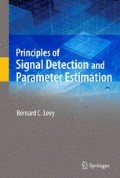Access this chapter
Tax calculation will be finalised at checkout
Purchases are for personal use only
Preview
Unable to display preview. Download preview PDF.
References
D. Bertsekas, Nonlinear Programming, Second Edition. Belmont, MA: Athena Scientific, 1999.
A. P. Dempster, N. M. Laird, and D. B. Rubin, “Maximum likelihood from incomplete data via the EM algorithm,” J. Royal Stat. Society, Series B, vol. 39, no. 1, pp. 1–38, 1977.
G. J. McLachlan and T. Krishnan, The EM Algorithm and Extensions. New York: J. Wiley & Sons, 1997.
C. F. J. Wu, “On the convergence properties of the EM algorithm,” Annals Statistics, vol. 11, pp. 95–103, 1983.
X.-L. Meng and D. van Dyk, “The EM algorithm – an old folk-song sung to a fast new tune,” J. Royal Stat. Soc., Series B, vol. 59, no. 3, pp. 511–567, 1997.
J. A. Fessler and A. Hero, “Space-alternating generalized expectation-maximization algorithm,” IEEE Trans. Signal Proc., vol. 42, pp. 2664–2677, Oct. 1994.
J. R. Magnus and H. Neudecker, Matrix Differential Calculus with Applications in Statistics and Econometrics. Chichester, England: J. Wiley & Sons, 1988.
X.-L. Meng and D. B. Rubin, “Using EM to obtain asymptotic variance-covariance matrices: The SEM algorithm,” J. Amer. Stat. Assoc., vol. 86, pp. 899–909, Dec. 1991.
R. H. Schumway and D. S. Stoffer, “An approach to time series smoothing and forecasting using the EM algorithm,” J. Time Series Analysis, vol. 3, pp. 253–264, 1982.
R. H. Schumway and D. S. Stoffer, Time Series Analysis and its Applications. New York: Springer-Verlag, 2000.
P. E. Caines, Linear Stochastic Systems. New York: J. Wiley & Sons, 1988.
L. Ljung, System Identification: Theory for the User, Second edition. Upper Saddle River, NJ: Prentice-Hall, 1999.
A. J. Laub, Matrix Analysis for Scientists and Engineers. Philadelphia, PA: Soc. for Industrial and Applied Math., 2005.
T. Kailath, A. H. Sayed, and B. Hassibi, Linear Estimation. Upper Saddle River, NJ: Prentice Hall, 2000.
F. A. Badawi, A. Lindquist, and M. Pavon, “A stochastic realization approach to the smoothing problem,” IEEE Trans. Automat. Control, vol. 24, pp. 878–888, 1979.
M. G. Bello, A. S. Willsky, B. C. Levy, and D. A. Castanon, “Smoothing error dynamics and their use in the solution of smoothing and mapping problems,” IEEE Trans. Informat. Theory, vol. 32, pp. 483–495, 1986.
M. G. Bello, A. S. Willsky, and B. C. Levy, “Construction and application of discrete-time smoothing error models,” Int. J. Control, vol. 50, pp. 203–223, 1989.
B. C. Levy, R. Frezza, and A. J. Krener, “Modeling and estimation of discrete-time Gaussian reciprocal processes,” IEEE Trans. Automatic Control, vol. 35, pp. 1013–1023, Sept. 1990.
S. M. Kay, Fundamentals of Statistical Signal Processing: Detection Theory. Prentice-Hall, 1998.
S. Chrétien and A. O. Hero, “Kullback proximal algorithms for maximum likelihood estimation,” IEEE Trans. Informat. Theory, vol. 46, pp. 1800–1810, Aug. 2000.
R. T. Rockafellar, “Monotone operators and the proximal point algorithm,” SIAM J. Control Optim., vol. 14, pp. 877–898, 1976.
X.-L. Meng and D. B. Rubin, “On the global and componentwise rates of convergence of the EM algorithm,” Linear Algebra Appl., vol. 199, pp. 413–425, 1994.
H. E. Rauch, F. Tung, and C. T. Striebel, “Maximum likelihood estimates of linear dynamic systems,” J. Amer. Inst. Aero. Astro., vol. 3, pp. 1445–1450, 1965.
S. M. Kay, Fundamentals of Statistical Signal Processing: Estimation Theory. Prentice-Hall, 1993.
K. S. Miller, Complex Stochastic Processes. Readings, MA: Addison-Wesley, 1974.
Author information
Authors and Affiliations
Rights and permissions
Copyright information
© 2008 Springer Science+Business Media, LLC
About this chapter
Cite this chapter
Levy, B.C. (2008). EM Estimation and Detection of Gaussian Signals with unknown parameters. In: Principles of Signal Detection and Parameter Estimation. Springer, Boston, MA. https://doi.org/10.1007/978-0-387-76544-0_11
Download citation
DOI: https://doi.org/10.1007/978-0-387-76544-0_11
Published:
Publisher Name: Springer, Boston, MA
Print ISBN: 978-0-387-76542-6
Online ISBN: 978-0-387-76544-0
eBook Packages: EngineeringEngineering (R0)

